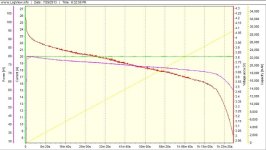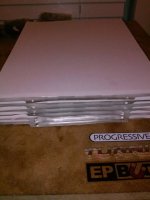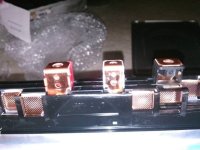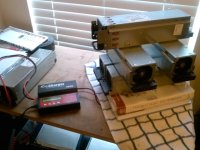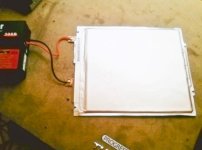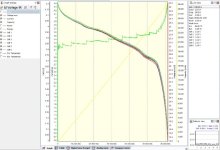You are using an out of date browser. It may not display this or other websites correctly.
You should upgrade or use an alternative browser.
You should upgrade or use an alternative browser.
Nissan Leaf Cells Test Data
- Thread starter icecube57
- Start date
icecube57
10 MW
10A 0.3c discharge only gave me about 200mah hours more.
The capacity between 3.0v and 2.75v was only 666mah
The capacity between 3.0v and 2.75v was only 666mah
pendragon8000
100 kW
wow thats interesting man, so you got the psu's on the books on the cell to keep it flat or what? funny looking shape, i guess ideal for a car or motorcycle, not so much ebike.
anythoughts about these cells?
what more can you tell us IceCube?
anythoughts about these cells?
what more can you tell us IceCube?
icecube57
10 MW
The cells are huge. They are the size of a piece of paper.
The tabs are actually pretty sturdy but fragile in its own way. The tabs have copper bus bars spot welded to the tabs. The spot welds look to be about .5x.5 inch on the tab. The copper bus bars are beefy but a pair of tin snips made quick work of of breaking the connections. I ended up cutting the bus bars to the exact size of the tabs. The copper bus bars welded to the tab make it easy to solder the tabs together. The -tab is copper and it tins without issue. The + tab is aluminum and you can't do anything with it which makes it important to try to extract the cells with the copper bus bars intact and cut the bus bars to size.
The cells have a two sided tape between the cells. I used a adhesive remover called krud kutter and a plastic spatula to pry the cells apart. The success of this was pretty good but if you get too aggressive in separating the cells you will wrinkle/ stretch the pouch and you cant massage the wrinkles away on some.
The cells have plastic spacers on the top and bottom of the cell and some type of rubber/glue is all around the perimeter of each cell. The cell spacers on the top of the cell snap together and provide protection for the bus bars to prevent accidental shorts and they hold the output terminals on the top of the cell.
The modules outer casing is made of aluminum. Its a huge glorified sardine can. The case can protect it from most dings but when they arrived in the mail it had some battle wounds. Although it protected the cells.. It did deform the case quite abit. I guess the mail people were throwing it around quite a bit.
The cell IR is around 5mohm according to my Icharger. The voltage stiffness or the lack thereof makes you think these are sorta like Thundersags or GBS cells without the bulk. You exchanged the bulk for an awkward cell size. On the upside you don't have to worry about series and paralleling a bunch of turnigy packs to get the capacity that you want.
As far as assembly. I think the assembly of the pack is going to be quite easy because of the copper buss bar being on the tabs. Without these bus bars on the tab i think it would be a pain in the but. I personally am going to assemble 6S sections and add a JST balance tap. Again this should be easy to solder. I think Im going to find some heat shrink and package it together nicely. Im going to isolate my tab connections with an appropriate tape and then put a neoprene foam cut to size to fill the voids. When complete the top tab area of the cell should be somewhat solid and should be ready for a few layers of heat shrink. Im also thinking about some type of plastic to give the cells some protection. Solder some 10G to the outputs. Im going to run 12S as my main pack and 18s for my extra power and extended range pack.
I plan put them in a pelican case or similar style case with a foam interior modified with an MTX trunk on the bottom so that it can use my existing slide lock rear rack.
The tabs are actually pretty sturdy but fragile in its own way. The tabs have copper bus bars spot welded to the tabs. The spot welds look to be about .5x.5 inch on the tab. The copper bus bars are beefy but a pair of tin snips made quick work of of breaking the connections. I ended up cutting the bus bars to the exact size of the tabs. The copper bus bars welded to the tab make it easy to solder the tabs together. The -tab is copper and it tins without issue. The + tab is aluminum and you can't do anything with it which makes it important to try to extract the cells with the copper bus bars intact and cut the bus bars to size.
The cells have a two sided tape between the cells. I used a adhesive remover called krud kutter and a plastic spatula to pry the cells apart. The success of this was pretty good but if you get too aggressive in separating the cells you will wrinkle/ stretch the pouch and you cant massage the wrinkles away on some.
The cells have plastic spacers on the top and bottom of the cell and some type of rubber/glue is all around the perimeter of each cell. The cell spacers on the top of the cell snap together and provide protection for the bus bars to prevent accidental shorts and they hold the output terminals on the top of the cell.
The modules outer casing is made of aluminum. Its a huge glorified sardine can. The case can protect it from most dings but when they arrived in the mail it had some battle wounds. Although it protected the cells.. It did deform the case quite abit. I guess the mail people were throwing it around quite a bit.
The cell IR is around 5mohm according to my Icharger. The voltage stiffness or the lack thereof makes you think these are sorta like Thundersags or GBS cells without the bulk. You exchanged the bulk for an awkward cell size. On the upside you don't have to worry about series and paralleling a bunch of turnigy packs to get the capacity that you want.
As far as assembly. I think the assembly of the pack is going to be quite easy because of the copper buss bar being on the tabs. Without these bus bars on the tab i think it would be a pain in the but. I personally am going to assemble 6S sections and add a JST balance tap. Again this should be easy to solder. I think Im going to find some heat shrink and package it together nicely. Im going to isolate my tab connections with an appropriate tape and then put a neoprene foam cut to size to fill the voids. When complete the top tab area of the cell should be somewhat solid and should be ready for a few layers of heat shrink. Im also thinking about some type of plastic to give the cells some protection. Solder some 10G to the outputs. Im going to run 12S as my main pack and 18s for my extra power and extended range pack.
I plan put them in a pelican case or similar style case with a foam interior modified with an MTX trunk on the bottom so that it can use my existing slide lock rear rack.
icecube57
10 MW
Battery module specs[2]
Number of cells 4
Construction 2 in-series pairs in parallel
Length 11.9291" (303 mm)
Width 8.7795" (223 mm)
Thickness 1.3779" (35 mm)
Weight 8.3775 lbs (3.8 kgs)
Output terminal M6 nut
Voltage sensing terminal M4 nut
Module fixing hole diameter 0.3582" (9.1 mm)
Cell specs[2]
Cell type Laminate type
Cathode material LiMn2O4 with LiNiO2
Anode material Graphite
Rated capacity (0.3C) 33.1 Ah
Average voltage 3.8 V
Length 11.417" (290 mm)
Width 8.504" (216 mm)
Thickness 0.2795" (7.1mm)
Weight 1.7624 lbs (799 g)
Number of cells 4
Construction 2 in-series pairs in parallel
Length 11.9291" (303 mm)
Width 8.7795" (223 mm)
Thickness 1.3779" (35 mm)
Weight 8.3775 lbs (3.8 kgs)
Output terminal M6 nut
Voltage sensing terminal M4 nut
Module fixing hole diameter 0.3582" (9.1 mm)
Cell specs[2]
Cell type Laminate type
Cathode material LiMn2O4 with LiNiO2
Anode material Graphite
Rated capacity (0.3C) 33.1 Ah
Average voltage 3.8 V
Length 11.417" (290 mm)
Width 8.504" (216 mm)
Thickness 0.2795" (7.1mm)
Weight 1.7624 lbs (799 g)
cal3thousand
10 MW
Good information here!
icecube57 said:Battery module specs[2]
Number of cells 4
Construction 2 in-series pairs in parallel
Length 11.9291" (303 mm)
Width 8.7795" (223 mm)
Thickness 1.3779" (35 mm)
Weight 8.3775 lbs (3.8 kgs)
Output terminal M6 nut
Voltage sensing terminal M4 nut
Module fixing hole diameter 0.3582" (9.1 mm)
Cell specs[2]
Cell type Laminate type
Cathode material LiMn2O4 with LiNiO2
Anode material Graphite
Rated capacity (0.3C) 33.1 Ah
Average voltage 3.8 V
Length 11.417" (290 mm)
Width 8.504" (216 mm)
Thickness 0.2795" (7.1mm)
Weight 1.7624 lbs (799 g)
That looks like 160wh/kg, just a little better than Lipo's 140wh/kg. Pretty cool. What kind of lifespan specs does this chemistry have? 300 cycles 'til 80% capacity? 1000? 2000?
etriker
100 kW
They have had problems with them.
http://www.greencarreports.com/news/1077107_more-nissan-leaf-battery-loss-nissan-doesnt-blink
http://green.autoblog.com/2012/10/10/nissan-andy-palmer-leaf-battery-degradation-crisis-video/
The customers are still testing them out ?
For $100 a month they will let you test out the newest battery setup and keep you straight ?
http://green.autoblog.com/2013/06/20/nissan-leaf-battery-replacement-will-cost-100-month/
http://www.greencarreports.com/news/1077107_more-nissan-leaf-battery-loss-nissan-doesnt-blink
http://green.autoblog.com/2012/10/10/nissan-andy-palmer-leaf-battery-degradation-crisis-video/
The customers are still testing them out ?
For $100 a month they will let you test out the newest battery setup and keep you straight ?
http://green.autoblog.com/2013/06/20/nissan-leaf-battery-replacement-will-cost-100-month/
etriker
100 kW
I just hope we don't have to buy all those used cells from China after they pick them over, bang them around and solder on them.
Harold in CR
100 kW
Icecube57, Would you mind sharing purchase info, like, where, how much, etc. ?? Maybe I missed that info, somewhere ? Thanks
icecube57
10 MW
Ok the cells come from a guy in Las Vegas.
http://www.ebay.com/itm/Prismatic-PHEV-EV-HV-Battery-LiMn2O4-LiFePO4-20AH-30AH-60AH-A123-Modulle-7-6V-/261218779197?pt=US_Rechargeable_Batteries&hash=item3cd1da403d
Hybrid Auto Center LLC
Nikolay Tranakiev
5360 Cameron St.
Ste. 5
Las Vegas, NV 89118
United States
Phone: 702-374-8692
Fax: 702-944-7871
deposit@hybridautocenter.com
http://www.ebay.com/itm/Prismatic-PHEV-EV-HV-Battery-LiMn2O4-LiFePO4-20AH-30AH-60AH-A123-Modulle-7-6V-/261218779197?pt=US_Rechargeable_Batteries&hash=item3cd1da403d
Hybrid Auto Center LLC
Nikolay Tranakiev
5360 Cameron St.
Ste. 5
Las Vegas, NV 89118
United States
Phone: 702-374-8692
Fax: 702-944-7871
deposit@hybridautocenter.com
icecube57
10 MW
I bought 5 modules and my cost was $560.
This turns out to be about $.20/wh shipped for about 2.7kwh $.19C without shipping factored in.
The adjusted cost due to the capacity loss is. $.23/wh for 2.3kwh $.22 without shipping factored in.
The individual cells are coming up to about 28.8AH 28.9 vs the 33.3AH. THe cells I have ... have already dropped in capacity by 13%. I think this came from a leaf with 35K which sounds about right from what I read.
Judging by the mileage and capacity loss it would seem that my modules may have came out a 2011 leaf.
This turns out to be about $.20/wh shipped for about 2.7kwh $.19C without shipping factored in.
The adjusted cost due to the capacity loss is. $.23/wh for 2.3kwh $.22 without shipping factored in.
The individual cells are coming up to about 28.8AH 28.9 vs the 33.3AH. THe cells I have ... have already dropped in capacity by 13%. I think this came from a leaf with 35K which sounds about right from what I read.
Judging by the mileage and capacity loss it would seem that my modules may have came out a 2011 leaf.
SamTexas
1 MW
I spent some time looking carefully at your test data and graph.
I must say that I'm not impressed at all with the cells. I was expecting a much better performing battery considering that it's LiMn2O4 and designed for a true electric car, by Nissan no less. What I saw instead is the same performance as a typical 18650 LiCo cell designed for laptops. The voltage sag is practically identical. The energy density is lower than the latest Panasonic 18650 cells. Hopefully it has a longer life than 18650 LiCo, but that does not appear to be the case if Tesla is correct.
Thanks for testing it. This is the first real test I've seen on LiMn2O4. All I have heard about it were praises without any data to back up.
I must say that I'm not impressed at all with the cells. I was expecting a much better performing battery considering that it's LiMn2O4 and designed for a true electric car, by Nissan no less. What I saw instead is the same performance as a typical 18650 LiCo cell designed for laptops. The voltage sag is practically identical. The energy density is lower than the latest Panasonic 18650 cells. Hopefully it has a longer life than 18650 LiCo, but that does not appear to be the case if Tesla is correct.
Thanks for testing it. This is the first real test I've seen on LiMn2O4. All I have heard about it were praises without any data to back up.
Icecube, thanks for the data. Hopefully my batch is better. If your batch are indeed the 35K version, then the sag/capacity you quoted is expected. <--- this is for SamTexas
Lets do the math:
35K miles/100 miles per charge = 350 cycles if the user charged every 100 miles. If they charge around every 50 miles, which makes more sense, then it will be 700 cycles on the battery.
If they are indeed rated for 60K miles, then I would say the cycles numbers for these battery if treated normally are around 1500 to 3000 charge cycles to 80% capacity depending on how you charge it.
80% of 33Ah is around 26Ah so even if it gets to that level and you don't mind the reduce capacity and sag, you should still get a legit 26Ah or 22Ah if you push it.
I'll baby mines and see how long they last.
@icecube, how did you test your battery. I have an icharge 1010b+ but have no idea how to do high current discharge and discharge to what? Any ideas?
Lets do the math:
35K miles/100 miles per charge = 350 cycles if the user charged every 100 miles. If they charge around every 50 miles, which makes more sense, then it will be 700 cycles on the battery.
If they are indeed rated for 60K miles, then I would say the cycles numbers for these battery if treated normally are around 1500 to 3000 charge cycles to 80% capacity depending on how you charge it.
80% of 33Ah is around 26Ah so even if it gets to that level and you don't mind the reduce capacity and sag, you should still get a legit 26Ah or 22Ah if you push it.
I'll baby mines and see how long they last.
@icecube, how did you test your battery. I have an icharge 1010b+ but have no idea how to do high current discharge and discharge to what? Any ideas?
SamTexas
1 MW
Well, none of the values used in your math is real. So the result is not meaningful.mvly said:Lets do the math:...
What I see is a battery from a Nissan Leaf, a relatively new car in the market.
mistercrash
10 kW
Thank you so much for all these results icecube. I'm not encouraged by those results. I find it's a shame. I'm no expert but isn't the voltage constantly going down? I don't think that's very beneficial, I'm used to see the voltage coming down fast at the beginning to a certain point then hit a plateau for some time until it drops down at the very end of the discharge. And 28.9Ah out of 33.3Ah is something like only 87% of the rated capacity. I don't think anyone would be happy buying A123 pouches rated at 20Ah that only give 17.4Ah.
SamTexas
1 MW
Only LiFePO4 has the characteristics you described. This is not LiFePO4.mistercrash said:I'm no expert but isn't the voltage constantly going down? I don't think that's very beneficial, I'm used to see the voltage coming down fast at the beginning to a certain point then hit a plateau for some time until it drops down at the very end of the discharge.
mistercrash
10 kW
I remember testing my hobby lipos, and they did have the characteristics I described. Once the load was applied, they would drop quickly from 4.2V to around 3.85v hitting a plateau that started at 3.85 and ended at around 3.7V before dropping dramatically to 3.0V at the very end of the discharge cycle.
Hillhater
100 TW
Well , actually what you see is a USED battery from a Nissan Leaf..... that has been used for many 100's of its cycle life expectancy.SamTexas said:What I see is a battery from a Nissan Leaf, a relatively new car in the market.
Which is why you would not expect it to still have its original Ahr capacity.
I am also surprised at the very low discharge (C) rate these are rated at !
SamTexas said:Well, none of the values used in your math is real. So the result is not meaningful.mvly said:Lets do the math:...
Well first off, the only results I noted is the charge cycles. The number I started with IS real. The 35K miles is what the odometer in the Leaf stated from the ebay seller. And that number you cannot prove is any less. But you cannot prove is anymore either. We are going to have to take the seller's words for it.
My point on the math is to reply your other point on how you were disappointed about the battery. Well I would love to see something with similar specs in capacity, power, weight, etc. do better noting the charge cycles on the battery.
Let's see RC lipo perform similarly after 350 cycles, let alone the more realistic number of 700 cycles on this pack. I doubt even RC Lipo will last this number of cycles before it sags much worst. The chinese LiFePo4 I played with crapped out < 200 cycles. Sure they were not A123 cells. But keep in mind the ability to obtain them at reasonable cost like icecude did here. I don't have Enerdel's NMC, EIG lipo, Kokam Lipo, or other legit cells. So I cannot comment on them. But then again who actually has numbers that prove they perform any better after 350-700 cycles on them. I suspect they do better, but by how much? You should also keep in mind the price. If you don't, then I can say I get the best cells right out of research lab with the best specs... but at what cost?
My conclusions is the results icecube put out is:
icecube57 said:I think this came from a leaf with 35K which sounds about right from what I read.
So it's expected. If you did expect something better, then I guess you will be waiting for a few more years.
Only LiFePO4 have those characteristics.mistercrash said:I'm used to see the voltage coming down fast at the beginning to a certain point then hit a plateau for some time until it drops down at the very end of the discharge.
A couple of things to note even though it might not make much difference.mistercrash said:And 28.9Ah out of 33.3Ah is something like only 87% of the rated capacity. I don't think anyone would be happy buying A123 pouches rated at 20Ah that only give 17.4Ah.
1) icecube tested them at 20A which is 0.6C vs what the specs used which is 0.3C. He did mentioned you get 200mAh more. So that makes it 29.2Ah
2) he also stopped at 3.0V, while, the specs stated you can go all the way down to 2.5V. He did say he got 666mAh more stopping at 2.75V. Let's make it 667mah
So 29.8/33.1 = 90%.
Finally keep in mind these came from a 35K Nissian Leaf. This equates to around 350-700 cycles on the battery already. Since these are rated at 60K miles before 80%, I say these number are right and expected. I don't have A123 cells, but I would love to see someone's prismatic A123 20Ah cells number after 350-700 cycles to see if it's above or below the 90% capacity like these cells.
etriker
100 kW
If they can push a car down the road then pushing an ebike should be no problem.
The price is right and recycling rules ?
The price is right and recycling rules ?
major
10 kW
mvly said:I don't have Enerdel's NMC, EIG lipo, Kokam Lipo, or other legit cells. So I cannot comment on them. But then again who actually has numbers that prove they perform any better after 350-700 cycles on them.
I've got a set of EnerDels with 3-400 cycles and no noticeable degradation in performance. I am not going to bench test one of the 384 cells to quantify anything precisely as that would void the final year of the 3 year warranty. Cycles are typically 60-70% DOD with an occasional 80% and a few 90%. I expect to see 250 to 300 cycles per year and a 7 to 10 year life ending with 80% capacity, maybe a bit lower.
I'm not saying I have numbers that prove anything, but offering a real life experience.
icecube57
10 MW
Umm you must not know about the B grade a123 20AH that are giving 18-19AH from one of the ebay vendors.
I must say out of the 6 Cells I have tested they all are giving me 28.8AH. Just as one of the previous posters said I think thats acceptable capacity. These weren't promised new. The performance on one cell ... my charger showed the cell at 6mohm I just assembled my first 6s pack and soldered balance taps in and I have 1mohms across the board for a total pack IR of 6mohms. Go figure.
Im currently balancing my 6s pack now and will do a discharge test. This discharge test will likely be at around 3A which is the 80w limit of my Icharger and will take roughly 10 hours.
I do have test data at 10A which has better voltage results. Less sag. But only gave me 200mah more.
I tested each cell individually. I soldered 6 inches of14 Gauge wire to the tabs. 4mm bullets on the end of those wires. I charged at 30A. Until the charger stopped. The voltage dropped to 4.15-4.16. I then dropped the charge rate down to 2A until it stopped. It put in roughly 400-500mah. The voltage held at 4.2. I discharged down to 3v a cell. The voltage of the cell rebounds to 3.2. When I went down to 2.75. I started from the 3.2v and discharged to 2.75 It gave me 666mah. Thats how I tested the cells.
I have a suspicion that these cells don't like the rapid charge rates considering that the leaf doesn't even charge the pack anywhere near 30A even with a 220v 30A setup its only 15A at the cell after the charger buck boosts it to 400+v.. The only time it sees any high rate charging is when its on a rapid charge which no one realistically has in their home. Which is 480v-125A.
I must say out of the 6 Cells I have tested they all are giving me 28.8AH. Just as one of the previous posters said I think thats acceptable capacity. These weren't promised new. The performance on one cell ... my charger showed the cell at 6mohm I just assembled my first 6s pack and soldered balance taps in and I have 1mohms across the board for a total pack IR of 6mohms. Go figure.
Im currently balancing my 6s pack now and will do a discharge test. This discharge test will likely be at around 3A which is the 80w limit of my Icharger and will take roughly 10 hours.
I do have test data at 10A which has better voltage results. Less sag. But only gave me 200mah more.
I tested each cell individually. I soldered 6 inches of14 Gauge wire to the tabs. 4mm bullets on the end of those wires. I charged at 30A. Until the charger stopped. The voltage dropped to 4.15-4.16. I then dropped the charge rate down to 2A until it stopped. It put in roughly 400-500mah. The voltage held at 4.2. I discharged down to 3v a cell. The voltage of the cell rebounds to 3.2. When I went down to 2.75. I started from the 3.2v and discharged to 2.75 It gave me 666mah. Thats how I tested the cells.
I have a suspicion that these cells don't like the rapid charge rates considering that the leaf doesn't even charge the pack anywhere near 30A even with a 220v 30A setup its only 15A at the cell after the charger buck boosts it to 400+v.. The only time it sees any high rate charging is when its on a rapid charge which no one realistically has in their home. Which is 480v-125A.
icecube57
10 MW
grindz145
1 MW
Awesome man! This is the first I've seen someone actually testing them. Thanks!
Similar threads
- Replies
- 2
- Views
- 657
- Replies
- 0
- Views
- 645
- Replies
- 13
- Views
- 1,438


